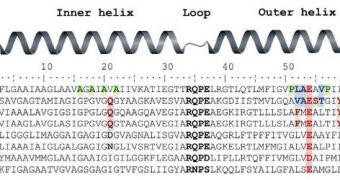A team of investigators recently conducted a new study into a key class of enzymes that they say is absolutely critical for all types of cells during energy conversion. Through the work was conducted on bacteria, the researchers say that the findings also hold relevance for the way human cells convert energy as well, inside specialized organelles called mitochondria. In the new study, experts looked at the proton-driven motors that exist on a class of important enzymes.
This is the first time that scientists manage an atomic-resolution view into these mysterious structures. These motors are essential for a major group of ATP synthases, molecules that play a very important role in energy conversion. The new research was conducted by experts at the Max Planck Institute of Biophysics, in Frankfurt, Germany, and Mount Sinai School of Medicine, in New York. The major achievement the team made was discovering that a water molecule exists inside a critical rotor element inside the bacterial motors. This structure is apparently very similar to the rotors of ATP synthases from human mitochondria.
ATP (adenosine triphosphate) is the main energy molecule inside the human body. We synthesize no less than 75 kilograms of it each single day, if we are resting. The amount is a lot larger when we are engaged in sustained physical effort. Understanding how ATP is produced, distributed and processed throughout the body is key to making sense of what goes on in the mitochondria, as well as to gaining more insight into how to stop a variety of bacterial infections. The microorganism Mycobacterium tuberculosis for example, which causes tuberculosis, shares some common features in its bacterial nano-motor with the rotors of ATP synthases from human mitochondria.
When we learn sufficient amount of data on this vulnerability we can easily synthesize chemicals to exploit it, and kill the bacteria. This is why discovering even the existence of a simple water molecule is such a giant step forward. Details of the discovery will appear in next week's issue of the open-access journal PLoS Biology. The work was conducted by MPI expert Dr. Thomas Meier, Dr. Ozkan Yildizhis, and PhD student Laura Preiss, and Mount Sinai colleagues Drs. Terry Krulwich and David Hicks.
“We did not expect a water molecule to be a key player in this group of rotors. This atomic structure gives us a new and much better framework for understanding how these proton-driven nano-machines work, how they capture the protons that fuel rotation and how they hold on to them through rotation.” Meier says.
“The results join other recent examples of the usefulness of unusual organisms, such as this 'extremophilic' bacillus, in providing insights into fundamental life processes and we look forward to further collaborative work on different forms of this rotor. Further basic research into the structural and mechanistic details of ATP synthase nano-machines will impact both nanotechnology and medicine and, perhaps, areas in which nanotechnology converges with medicine,” he concludes.

 14 DAY TRIAL //
14 DAY TRIAL //